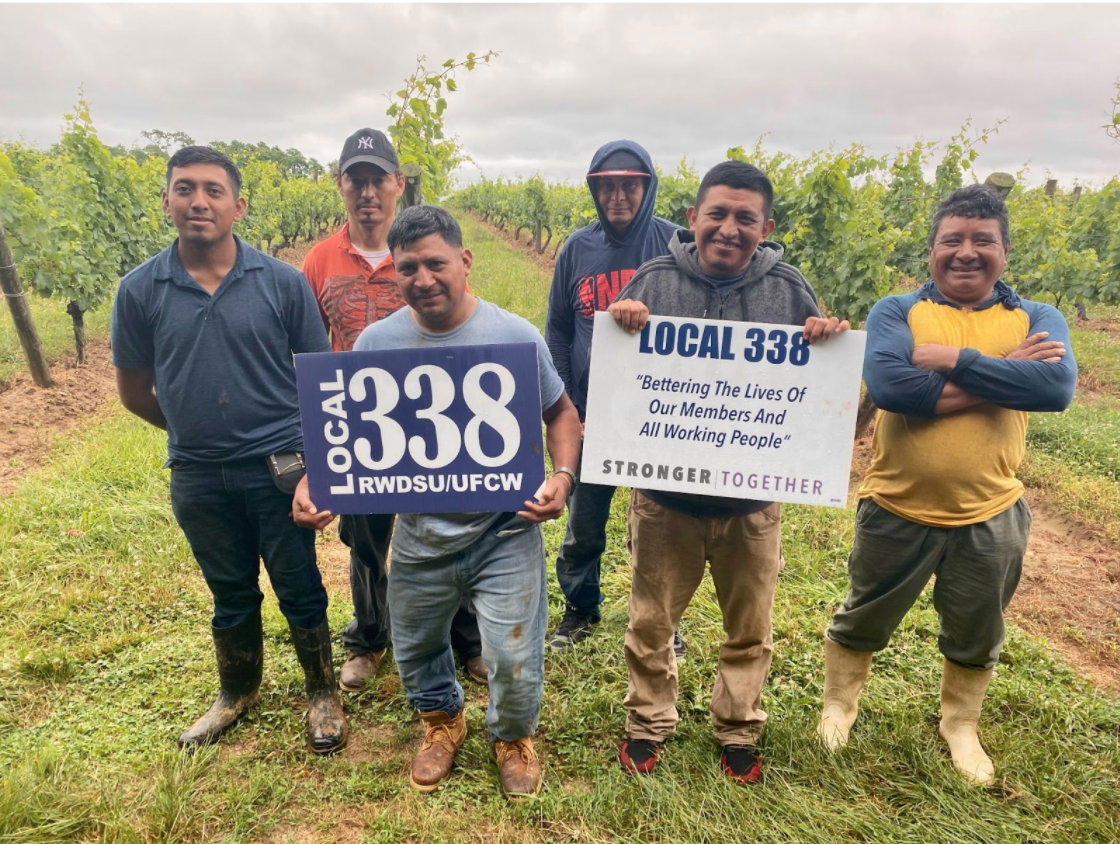On September 27, a group of workers at a Long Island vineyard formed the first farmworkers union in the history of New York State, according to advocates. After decades of fighting for this right, farmworkers and advocates hope these workers will be the first of many to unionize in New York as farmworkers have been historically excluded from advancements in labor rights.
Twelve workers from Pindar Vineyards in Peconic, Long Island, joined the Local 338 RWDSU/UFCW union on September 27, 2021, making them the first certified union for farmworkers in the state. Farmworkers previously were not allowed to unionize before the passage of the Farm Laborers Fair Labor Practices Act in 2019, which gave them the right to collectively bargain and provided other protections like overtime pay and workers’ compensation.
Pindar Vineyards, the largest vineyard on Long Island, is situated on over 500 acres on the North Fork. It produces tens of thousands of cases of wine per year. Visitors can taste the wines on a sprawling deck with red umbrellas that overlook the rows of green vines.
Also Read: New York Farmworkers Removed From Vaccine Eligibility Without Explanation
Originally from Guatemala, he arrived in the U.S. in 2007. Before working at Pindar, he worked at another Long Island vineyard.
“In Guatemala, the unions are strong and well-organized,” said Rodolfo Mendez, a worker at Pindar. Originally from Guatemala, Mendez arrived in the U.S. in 2007. Before working at Pindar, he worked at another Long Island vineyard. “And now that opportunity has arrived for us and we are moving forward.”
Noemi Barrera, an organizer with Local 338 RWDSU/UFCW who ran the campaign to get Pindar workers unionized, said when the pandemic began, the workers weren’t provided personal protective equipment. Producing wine requires workers to be in close quarters and they often live close together as well. Pindar did not respond to multiple requests for comment.
After the pandemic began, Barrera started going to the vineyard and distributing the masks and hand sanitizer the workers needed. While she passed around the supplies, she would tell the workers about the new law and that they were able to unionize.
“They were very standoffish at the beginning,” said Barrera. “We had to build upon the relationship one by one, here and there, and they finally agreed to meet.”
She organized a meeting in a field where she explained further. Eight workers came. She organized another meeting at a pizzeria, and told them to come if they were serious. Ten workers showed up and listened as she told them the steps in the process and how to prepare themselves.
The fight to unionize farmworkers — who are often excluded from labor laws that apply to other workers — goes back to the National Labor Relations Act of 1935, signed into law by President Franklin Roosevelt. This law, also called the Wagner Act, allowed workers to unionize and prevented employers from retaliating against workers who joined a union — with the exception of agricultural or domestic workers. At the time, many of these workers were Black and Roosevelt had compromised on the law with the Southern Democrats, who wanted to continue discriminating against and oppressing people of color.
In 1937, New York passed the New York State Employment Relations Act (SERA), modeled off the Wagner Act. The Wagner Act only covered laborers in industries which affected interstate commerce, so SERA was designed to include more workers in the state. However, SERA kept the part of the law which excluded farmworkers.
A year later, Roosevelt signed the Fair Labor Standards Act (FLSA) into law. The FLSA provided a minimum wage and overtime, but farmworkers were left out yet again due to Southern lobbying. In 1966, the FLSA was amended to include some of the provisions for farmworkers, but workers were still not granted overtime pay and workers on small farms were not guaranteed minimum wage.
In New York State, efforts to guarantee collective bargaining and overtime pay for farmworkers go back to the 1980s and 1990s, when smaller laws were passed that guaranteed rights for farmworkers. In 1987, Governor Mario Cuomo vetoed state legislation that would exempt agricultural laborers from the state’s pesticide notification laws – the veto helped protect workers from the chemicals being sprayed in the fields. A law passed in 1996 requiring employers to provide drinking water for all workers (the previous law only required this when farms employed five or more workers). In 1998, a law passed requiring toilets and handwashing facilities for all field workers (earlier legislation had only required this for farms with 11 or more workers). In 1999, another law passed that tied minimum wage for farmworkers to the state minimum wage.
At that point in 1999, the Justice for Farmworkers Campaign, a statewide effort aimed at passing legislation for farmworkers led by Rural and Migrant Ministry, decided to focus on the umbrella of issues affecting agricultural laborers, rather than solving problems one at a time. The first version of the Farm Laborers Fair Labor Practices Act was introduced in 2000. It would spend nearly 20 years tied up in the state senate.
Also Read: Farmworkers Struggle to Unionize in New York. Crispin Hernandez May Change That
In 2016, a group of farmworkers led by Crispin Hernandez and represented by the NYCLU sued the State of New York, alleging that SERA violated the New York State Constitution by excluding farm laborers from the protections it afforded other workers. The state declined to argue the case and the New York Farm Bureau, which represents agricultural interests, intervened in the case as a defendant. After a lengthy court battle, a state appellate court ruled in May 2019 that the workers did have the constitutional right to organize.
A month later, in June 2019, the Farm Laborers Fair Labor Practices Act finally passed due to a Democratic majority in the New York State Senate, granting workers overtime pay, a day of rest, disability and paid family leave coverage, unemployment benefits and the right to organize. To satisfy the agricultural interests in the state, the law included a provision that although workers could unionize, they could not strike. Governor Andrew Cuomo signed the bill into law that July and it took effect on January 1, 2020.
“We said all along that the legislation wasn’t the most important thing,” said Rev. Richard Witt, the executive director of Rural and Migrant Ministry. “It was just removing these barriers so that farmworkers could actually organize.”
But the efforts to unionize farmworkers after the law took effect were soon derailed by the COVID-19 pandemic.
“We were zapped by COVID, so it made it very hard to be out building relationships,” Witt said.
Union organizing amongst farmworkers is challenging even in non-pandemic times. Many agricultural jobs are seasonal, so workers can leave for months at a time, which disrupts organizing campaigns. Many workers are undocumented, and fear retaliation from an employer as a result of organizing. Workers often do not know their rights or have little previous experience with unions. And the rural nature of farming provides additional difficulties.
“There’s no factory gate where organizers can hang around for when workers get off work,” said Margaret Gray, associate professor of political science at Adelphi University, whose work focuses on agricultural laborers. “Even if you have an address to a farm, there’s no guarantee that’s going to bring you to where you might find workers.”
Local 338 RWDSU/UFCW first filed to represent the workers of Pindar at the end of May. The process took longer than the organizer, Barrera, had expected. She told the workers to be patient, thanking them for their trust. Finally, on September 27, the New York State Public Employment Relations Board certified the union to represent the twelve employees from the vineyard.
Also Read: First Farmworker Union Forms in New York State
Mendez, the employee, said he and his fellow workers were going to negotiate for days of rest, paid holidays, vacations and sick leave.
“[We want] to be respected and recognized for our work,” said Mendez. “And not be discriminated against by anybody.”
Gray said unionizing is often thought of as a “zero-sum game, where workers gain something and farm employers lose something.” Yet evidence shows union workers are often happier workers, who become more invested in the companies they work for.
“New York farmers are extremely savvy,” said Gray. “I think that there’s an opportunity here for farmers to start to market their products as union-proud… A label showing up at a farm stand or on a bottle of wine or on milk containers could really be a boon for farmers’ sales.”
On Long Island, Local 338 RWDSU/UFCW has already filed to represent another set of workers.
“We’d like to be an example to encourage others to come, to get involved, because it’s necessary,” said Mendez. “We want to make the movement bigger, so everyone can fight for their dignity.














